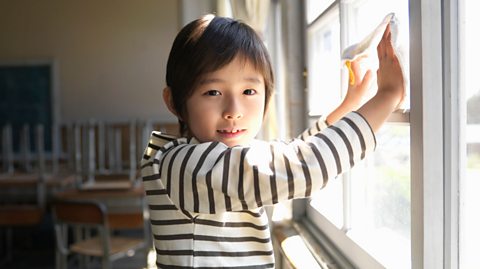This article was first published in August 2019
Your school experience is likely to have varied from the next personÔÇÖs but what would it have been like if youÔÇÖd lived in a different country altogether? Here are five school practices you might be less familiar with!
1. Forest Schools, Sweden
 Image source, Getty Images
Image source, Getty ImagesDid you know it is mandatory for children in Sweden to attend school from the year they turn six? This means that in the years leading up to this, they can choose to attend pre-school or ┤┌├Â░¨▓§░ý┤Ã▒¶▓╣. One option to get children learning in these early years is Skogsmulle - an early years teaching pedagogy which focuses on outdoor learning.
The idea has been popular across Scandinavia but it came to Sweden in the 1950s when G├Âsta Frohm wanted to re-connect children with nature and so set up a school for children aged five to six. He utilised the character of ÔÇÿSkogsmulleÔÇÖ (a character ÔÇÿliving in the forestÔÇÖ) to encourage children to explore their natural surroundings. The idea is popular around the world with ÔÇÿForest SchoolsÔÇÖ appearing in the Germany, UK, USA, Australia and beyond.
2. Cleaning, Japan
 Image source, Getty Images
Image source, Getty ImagesWhilst in the UK children might tidy their classroom or put their leftovers in the bin after lunch, Japanese school life takes it one step further. From a young age, children are tasked with helping to clean and maintain their school after the school day finishes. This includes wiping windows, sweeping and mopping the floor, dusting desks and even serving lunch to each other.
It is thought that, by cleaning up after themselves, children take on a sense of responsibility for their environment.
3. School lunches, France
 Image source, Getty Images
Image source, Getty ImagesTeaching children about the importance of healthy food is a priority in France. One of the main ways this is done is by offering nutritious food in schools as well as ensuring children establish a good routine and good attitude towards mealtimes ÔÇô they are expected to stay in their seat for at least thirty minutes to allow food to be eaten.
When children start school, they eat four courses for lunch. This usually consists of a cold starter, a warm main course, followed by cheese and then dessert ÔÇô generally fresh fruit! Not forgetting an accompaniment of a slice of bread and a glass of water.
4. Cycling to school, Denmark
 Image source, Getty Images
Image source, Getty ImagesHow did you get to school? From their first day, children in Denmark are encouraged to think carefully about which option to choose ÔÇô this includes cycling! In Odense, the third largest city in Denmark, different initiatives exist to help children become more confident in riding a bike which has led to a significant number using this form of transport for the school run.
Initiatives range from bicycle summer schools where children can learn the basics ahead of going to school to the construction of hundreds of kilometres of cycle paths.
5. Indoor playtime, Canada
 Image source, Getty Images
Image source, Getty ImagesHow cold is too cold? In Canada, winter temperatures can drop far below freezing. In regions such as Ontario many schools either shorten playtime or keep children indoors at break time entirely if temperatures reach below -20┬░C to -28┬░C. This means that children must be sure to keep active indoors to avoid a lack of physical activity during winter.
On days when temperatures plummet even further, children can avoid going to school altogether! On the other days, children must navigate getting to school despite the snow. At least in Toronto there is a network of underground tunnels so that you can shelter from the cold and still get where you need to go whilst briefly escaping the chill.
Know someone starting primary school soon? Check out the rest of which has lots of ways to help prepare children for different aspects of school life ÔÇô both practically and emotionally.